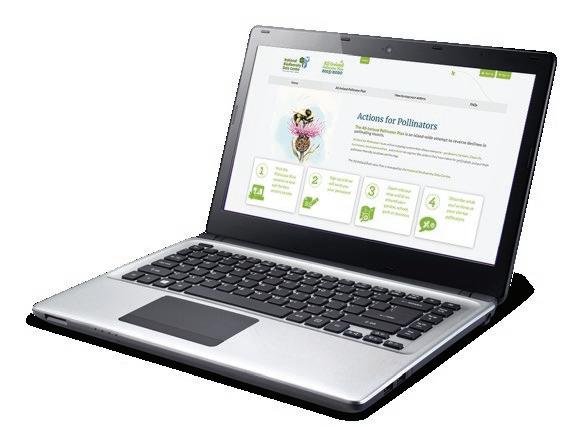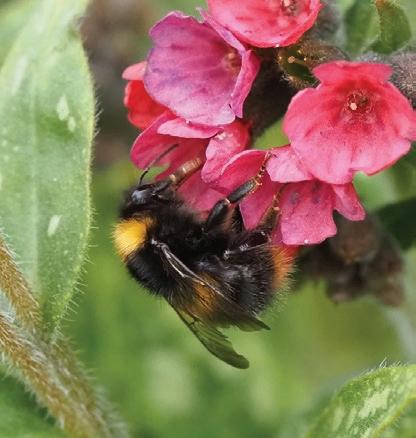
10 minute read
Objective 06 Strategic coordination of the Plan
OBJECTIVE 06
Strategic coordination of the Plan
Advertisement
Targets for 2021–2025:
TARGET 6.1 General awareness raising
TARGET 6.2 Researching the evidence base for action
TARGET 6.3 Establishment and maintenance of supporting databases
TARGET 6.4 Maintenance of a network of supporting organisations
TARGET 6.5 Overall coordination
Target 6.1
General awareness raising
6.1 Action
143 Continually maintain and update AIPP website to provide stand-alone toolkit for those who want to help.
Progress measure
Continued management and updating of website www.pollinators.ie
144 Maintain Twitter and Instagram accounts. Growth in the number of followers Run dedicated annual campaigns on both platforms. May include, but not limited to: Let Dandelions Be, No Mow May AIPP team
Responsibility
AIPP team
145 Promote the AIPP in national and local media.
146 Focus engagement efforts on new audiences. Maintain up-to-date media toolkit, to include bank of photographs Publish press release for key events Development of a range of promotional materials to promote pollinators Track numbers of published media articles and other engagements AIPP team
Number of engagement efforts with new sectors who have not heavily engaged with the 2015–2020 Plan AIPP team
147 Distribute a monthly digital newsletter to the mailing list. Digital newsletter distributed to the mailing list each month AIPP team
148 Organise an annual AIPP conference. Annual event organised to provide a forum for knowledge sharing and reporting on progress within the Plan Meeting venue to rotate around Provinces AIPP team
149 Run an annual programme of engagement around World Bee Day (20th May). Programme of engagement organised Activities listed on a dedicated page on pollinators.ie. All partners
150 Run an annual programme of engagement around international Pollinator Week (late June). Programme of engagement organised Activities listed on a dedicated page on pollinators.ie. All partners
151 Recognise the contribution of local pollinator ambassadors/champions. Since 2017, we have recognized a small group of individuals annually (approx. six). This to continue. These are local influencers who make the plan happen on the ground, largely in a voluntary capacity Certificate and personal thanks are sent to new pollinator champions. Awardees are not publicised, as these are most often people who do not wish to be personally promoted AIPP team
6.1 Action
152 Raise awareness of an additional pollinating insect group annually. (The main focus of the All-Ireland Pollinator Plan is on bees.)
Progress measure
Social media campaign to raise awareness of one non-bee pollinating insect group annually. May include, but not limited to: hoverflies, nocturnal pollinators, day-flying moths, wasps, beetles
Responsibility
Butterfly Conservation NI, BugLife, others as appropriate
153 Raise awareness to promote the use of appropriate grass management in preference to planting with wildflower seed and, where this is necessary, the use of native, local provenance wildflower seed. Continued messaging through social media and other online platforms AIPP team
Target 6.2
Researching the evidence base for action
NOTE: Research actions are dependent on both funding and availability of appropriate researchers
6.2 Action Progress measure
Dissemination and communication
154 Maintain the Pollinator Research Network to discuss ongoing research, and to build collaborations for future research. Annual Pollinator Research Network meetings held Annual updates of researchers/research projects disseminated via pollinators.ie Pollinator Research Network – Trinity College Dublin (TCD), University College Dublin (UCD), Maynooth University (MU), Dublin City University (DCU), National University of Ireland, Galway, Waterford Institute of Technology (WIT), and others
Responsibility
155 Maintain bee health research-policy-practice dialogue. Annual Bee Health meetings between researchers, decisionmakers, and practitioners. MU, TCD, DAFM, Teagasc, AFBI, DAERA
6.2 Action Progress measure
Pollinator and pollination ecology
156 Expand knowledge of Ireland’s wild bee populations. Research into genetic differentiation/distinction among populations at different scales, linking with ecological/ behavioural differences Research into nesting and floral requirements of solitary bee species Continue to investigate the prevalence, health and longevity of honeybee colonies that exist in the wild.
Responsibility
Researchers
157 Improve understanding of hoverfly populations. Research into hoverfly abundance/diversity across different land uses, microhabitat use, and/or service provision (biocontrol, pollination, nutrient cycling). Researchers
158 Improve knowledge of rare and at-risk pollinators. Research to inform conservation of extinction-risk species in the Irish context Provide evidence base for conservation of specialized habitats in which rare/at-risk species live. Researchers, NPWS
159 Expand knowledge of urban pollinators. Research to determine impacts of street lighting on pollinators and pollination service Research to determine value of urban greening to pollinator populations. Researchers
160 Expand knowledge of plant-pollinator interactions and dynamics, and pollination service delivery. Continue research into farmland pollinators, how they respond to changes in floral availability within and between seasons Research linking changes in pollinator communities with ecosystem function and service provision in wild plant species. Researchers
161 Expand understanding of interactions between managed and wild pollinators. Investigate optimal placement of honeybee apiaries – how do honeybee hives affect availability of floral resources for other pollinators and how many hives should be located in different habitat types (e.g., forests, urban areas, farmed landscapes).
162 Expand knowledge of bee diseases and health risks. Generate baselines of disease prevalence in honeybees and investigate potential for disease transfer Determine whether promotion of managed honeybee colonies in the wild poses a disease risk to wild pollinators Undertake new research into Chalkbrood disease in honeybees. Researchers, DAFM, AFBI, DAERA
Researchers, Beekeepers
6.2 Action Progress measure
Drivers of decline and conservation measures
163 Understand extent of exposure to pesticides and other pollutants across ecosystems. Determine exposure routes for multiple pesticides/ pollutants and pollinator taxa Quantify pesticide residues in plants, soil, water, bee products Improve understanding of impacts of environmental pollution, e.g. heavy metals on bee health and bee products. Researchers, DAFM
164 Research impacts of climate change and climate action policies on pollinators. Research into how climate change affects pollinators Research into how policies to tackle climate change affect pollinators. Researchers
165 Assess effectiveness of conservation measures. Research effectiveness of conservation actions for pollinator populations and communities Develop a simple tool to assess quality of conservation actions (e.g. meadows, parks, designated sites, no-mow lawns, Buglife’s B-lines) in terms of provision of floral resources
166 Determine effectiveness of Pollinator Trail sites Research to monitor the network of Pollinator Trail sites to specifically assess the impact of different pollinator actions versus control sites
Responsibility
Researchers
Researchers
167 Investigate the role of specific plants in supporting pollinators to determine best ones to plant for bees in different habitat types. Research into role of trees to inform tree-planting initiatives Research into replacements for invasive plants used by beekeepers to provide forage for honeybees (e.g. Himalayan
Balsam) Researchers
168 Review publicly managed land in terms of suitability for key pollinator populations. Conduct review Develop a plan to prioritise the restoration of pollinator habitat, based on those areas that will yield the greatest expected net benefits Researchers, National Biodiversity Data Centre
Multiple benefits and widening engagement
169 Research multiple co-benefits of pollinator conservation for other elements of biodiversity and ecosystem service delivery. Research into co-benefits of pollinator conservation actions Researchers
170 Expand understanding of why people engage with pollinator conservation and how to reach those who are not yet engaging. Cross-disciplinary research into engagement with pollinator conservation action. To include studies of behaviour change, attitudes, perceptions, etc. Researchers
6.2 Action
171 Test methods for nonlethal monitoring across habitats.
Progress measure
Pilot studies and ground truthing of novel non-lethal monitoring technology, compatible with European Pollinator
Monitoring Scheme Researchers, DAFM, National Biodiversity Data Centre
Responsibility
Target 6.3
6.3 Action
172 Continue to manage and maintain the online mapping system Actions for Pollinators, where all those who have taken pollinatorfriendly actions can log their location and the action(s) taken.
Progress measure
Manage and maintain the GIS based mapping system Open it up to all sectors Improve reporting by increasing the number of sites logged Where funding is available, work to expand the functionality of the system Use this emerging map of pollinator-friendly habitat to direct future actions to the most appropriate areas National Biodiversity Data Centre
Responsibility
pollinators.biodiversityireland.ie
6.3 Action

173 Maintain data on wild pollinator distribution and make available through an online Atlas of Irish pollinators and the NBN Atlas for Northern Ireland.
Progress measure
Maintain and manage databases. Ensure that as much data is open access as possible Make available through online Atlases of wild bees and hoverflies Increase the number of active recorders who can accurately identify pollinator species Where funding is available, continue to develop and publish online identification courses for pollinator identification
Responsibility
National Biodiversity Data Centre; CEDaR
6.3 Action
174 Maintain and grow Citizen Science pollinator monitoring networks and databases.
Progress measure
Continue to support and grow the All-Ireland Bumblebee
Monitoring Scheme . This is an expert-level Citizen Science scheme. Continue to support and grow the Flower-Insect Timed
Count monitoring scheme . This is a beginner-level Citizen
Science scheme. National Biodiversity Data Centre
175 Maintain a database on plant-pollinator interactions. Maintain database Add new data as it becomes available National Biodiversity Data Centre
176 Maintain an online database of Irish Pollinator research. Establish and populate database Make available via www.pollinators.ie Update annually Pollinator Research Network
Responsibility
177 Develop a digital database of pollinator collections in the National Museum of Ireland (Natural History). Investigate funding mechanisms that would allow the national bee collection to be fully curated by the Natural
History Museum. This should include image, accession number, specimen - all digitally linked and searchable National Museum of Ireland (Natural History)
178 Collate and maintain data on scientific engagement polls/ surveys, so that the initiative can continue to learn from this feedback. Maintain a database of the findings of all engagement polls since the AIPP began in 2015. Some of these were run by the
Plan itself through social media, others by third parties Use this information to improve engagement with all stakeholders AIPP team
Target 6.4
6.4 Action
179 Maintain a network of organisations who agree to help promote or otherwise assist the All-Ireland Pollinator Plan.
Progress measure
Create a framework, whereby organisations can sign up as a supporter of the Plan and indicate what actions they are willing to take in support (template on page 62) Maintain a list of all supporting organisations on the website Maintain this network of supporting organisations and provide support as resources allow Facilitate knowledge exchange where possible Provide supporters with an opportunity to report on their activities each year as part of the annual review process AIPP team
Responsibility
Target 6.5
Overall coordination
6.5 Action
180 Promote the Plan to new organisations and sectors as relevant.
181 Ensure that the Pollinator Plan is compatible with other biodiversity initiatives.
Progress measure
Plan promoted to new organisations and sectors Increase in the number of organisations supporting the Plan As appropriate, continue to explore possibilities to grow the reach of the Plan e.g. investigations into whether the planning process could include stipulations for pollinators AIPP Project Manager and Steering Group
Liaise with other partners to ensure land management advice for promoting biodiversity is joined up and is not contradictive AIPP Project Manager and Steering Group
Responsibility
182 Ensure the incorporation of the Pollinator Plan into future relevant national strategies, where appropriate. Promotion of the Plan to relevant organisations and those working on national strategies/planning AIPP Project Manager and Steering Group
183 Develop an online toolkit, based on lessons learned from the AIPP 2015–2020 to ensure knowledge sharing at the EU level and beyond. Develop materials on lessons learned from the first phase of the All-Ireland Pollinator Plan 2015–2020 Make available as an online toolkit for other countries interested in doing something similar Include templates and resources that can be shared
184 Publish an overall annual review of the 186 actions in the Plan. Development of a collated annual review, outlining progress on all actions within the Plan Publication of this annual review on the website each
December AIPP Project Manager
AIPP Project Manager
185 Annually review the Steering Group. Review the Steering Group annually and restructure as required AIPP Steering Group Chair
186 Renew the Plan in 2025. A new version of the Pollinator Plan to be developed for 2026–2030 Steering Group










